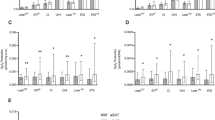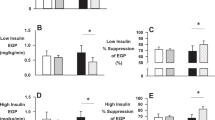Abstract
Background/Objectives:
Skeletal muscle plays important role in the regulation of whole-body metabolism. In skeletal muscle, uptakes of glucose and fatty acid from circulation are facilitated by transmembrane substrate transporters GLUT4 and FAT/CD36, respectively. The aim of this study was to determine the effect of dietary glycemic index (GI) on GLUT4 and FAT/CD36 gene expressions in human skeletal muscle after a single bout of exercise.
Subjects/Methods:
Eight male subjects completed a 60-min cycling exercise at 75% maximal oxygen consumption (VO2 max), and were immediately fed an isocaloric meal containing either high-GI (HGI) or low-GI (LGI) diets, with similar proportions of carbohydrate, fat and protein in a crossover design. Muscle samples from deep vastus lateralis were taken by needle biopsy immediately after exercise and 3 h after exercise.
Results:
After exercise, the HGI diet produced significantly greater glucose and insulin responses compared with the LGI diet, as indicated by the greater area under the curves. Both diets resulted in rapid reductions in plasma fatty acid and glycerol below fasting level. GLUT4 mRNA was downregulated by both HGI and LGI diets to a comparable extent, whereas GLUT4 protein levels were not changed during this short period. FAT/CD36 mRNA and protein levels were substantially decreased with the HGI diet below baseline, but not with the LGI diet.
Conclusion:
This study found a significant dietary GI effect on post-exercise FAT/CD36 gene expression in human skeletal muscle. This result implicates that the differences in dietary GI are sufficient to alter fat metabolism.
This is a preview of subscription content, access via your institution
Access options
Subscribe to this journal
Receive 12 print issues and online access
$259.00 per year
only $21.58 per issue
Buy this article
- Purchase on Springer Link
- Instant access to full article PDF
Prices may be subject to local taxes which are calculated during checkout






Similar content being viewed by others
References
Arkinstall MJ, Tunstall RJ, Cameron-Smith D, Hawley JA (2004). Regulation of metabolic genes in human skeletal muscle by short-term exercise and diet manipulation. Am J Physiol 287, E25–E31.
Bergstrom J (1962). Muscle electrolytes in man determined by neutron activation analysis on needle biopsy specimens: a study on normal subjects, kidney patients, and patients with chronic diarrhoea. Scand J Clin Lab Invest 14, 7–110.
Bonen A, Dyck DJ, Luiken JJ (1998). Skeletal muscle fatty acid transport and transporters. Adv Exp Med Biol 441, 193–205.
Cameron-Smith D, Burke LM, Angus DJ, Tunstall RJ, Cox GR, Bonen A et al. (2003). A short-term, high-fat diet up-regulates lipid metabolism and gene expression in human skeletal muscle. Am J Clin Nutr 77, 313–318.
Cheng IS, Lee NY, Liu KL, Liao SF, Huang CH, Kuo CH (2005). Effect of postexercise carbohydrate supplementation on glucose uptake-associated gene expression in the human skeletal muscle. J Nutr Biochem 16, 267–271.
Civitarese AE, Hesselink MKC, Russell AP, Ravussin E, Schrauwen P (2005). Glucose ingestion during exercise blunts exercise-induced gene expression of skeletal muscle fat oxidative genes. Am J Physiol 289, E1023–E1029.
Cluberton LJ, McGee SL, Murphy RM, Hargreaves M (2005). Effect of carbohydrate ingestion on exercise-induced alterations in metabolic gene expression. J Appl Physiol 99, 1359–1363.
Duplus E, Glorian M, Forest C (2000). Fatty acid regulation of gene transcription. J Biol Chem 275, 30749–30752.
Franch J, Andersen J, Jensen J, Pedersen P, Knudsen J (2002). Acyl-coenzyme A binding protein expression is fibre-type specific in rat skeletal muscle but not affected by moderate endurance training. Pflügers Archiv Eur J Physiol 443, 387–393.
Groop LC, Bonadonna RC, Shank M, Petrides AS, DeFronzo RA (1991). Role of free fatty acids and insulin in determining free fatty acid and lipid oxidation in man. J Clin Invest 87, 83–89.
Hildebrandt AL, Pilegaard H, Neufer PD (2003). Differential transcriptional activation of select metabolic genes in response to variations in exercise intensity and duration. Am J Physiol Endocrinol Metab 285, E1021–E1027.
Jump DB, Clarke SD (1999). Regulation of gene expression by dietary fat. Annu Rev Nutr 19, 63–90.
Kraniou GN, Cameron-Smith D, Hargreaves M (2006). Acute exercise and GLUT4 expression in human skeletal muscle: influence of exercise intensity. J Appl Physiol 101, 934–937.
Kuo CH, Browning KS, Ivy JL (1999a). Regulation of GLUT4 protein expression and glycogen storage after prolonged exercise. Acta Physiol Scand 165, 193–201.
Kuo CH, Hunt DG, Ding Z, Ivy JL (1999b). Effect of carbohydrate supplementation on postexercise GLUT-4 protein expression in skeletal muscle. J Appl Physiol 87, 2290–2295.
Laurell S, Tibbling G (1966). An enzymatic fluorometric micro-method for the determination of glycerol. Clin Chim Acta 13, 317.
Liang CP, Han S, Okamoto H, Carnemolla R, Tabas I, Accili D et al. (2004). Increased CD36 protein as a response to defective insulin signaling in macrophages. J Clin Invest 113, 764–773.
Luiken JJFP, Arumugam Y, Bell RC, Calles-Escandon J, Tandon NN, Glatz JFC et al. (2002). Changes in fatty acid transport and transporters are related to the severity of insulin deficiency. Am J Physiol 283, E612–E621.
Qiao L, Zou C, Shao P, Schaack J, Johnson PF, Shao J (2008). Transcriptional regulation of fatty acid translocase/CD36 expression by CCAAT/enhancer-binding prot. J Biol Chem 283, 8788–8795.
Reaven GM (1988). Banting lecture 1988. Role of insulin resistance in human disease. Diabetes 37, 1595–1607.
Salceda S, Caro J (1997). Hypoxia-inducible factor 1alpha (HIF-1alpha) protein is rapidly degraded by the ubiquitin-proteasome system under normoxic conditions. Its stabilization by hypoxia depends on redox-induced changes. J Biol Chem 272, 22642–22647.
Shearer J, Wilson RJ, Battram DS, Richter EA, Robinson DL, Bakovic M et al. (2005). Increases in glycogenin and glycogenin mRNA accompany glycogen resynthesis in human skeletal muscle. Am J Physiol Endocrinol Metab 289, E508–E514.
Smith AC, Mullen KL, Junkin KA, Nickerson J, Chabowski A, Bonen A et al. (2007). Metformin and exercise reduce muscle FAT/CD36 and lipid accumulation and blunt the progression of high-fat diet-induced hyperglycemia. Am J Physiol 293, E172–E181.
Tunstall RJ, Mehan KA, Wadley GD, Collier GR, Bonen A, Hargreaves M et al. (2002). Exercise training increases lipid metabolism gene expression in human skeletal muscle. Am J Physiol 283, E66–E72.
Vanden Heuvel JP, Clark GC, Kohn MC, Tritscher AM, Greenlee WF, Lucier GW et al. (1994). Dioxin-responsive genes: examination of dose-response relationships using quantitative reverse transcriptase-polymerase chain reaction. Cancer Res 54, 62–68.
Wilson RJ, Gusba JE, Robinson DL, Graham TE (2007). Glycogenin protein and mRNA expression in response to changing glycogen concentration in exercise and recovery. Am J Physiol Endocrinol Metab 292, E1815–E1822.
Zurlo F, Larson K, Bogardus C, Ravussin E (1990). Skeletal muscle metabolism is a major determinant of resting energy expenditure. J Clin Invest 86, 1423–1427.
Acknowledgements
This study was sponsored, in part, by a grant from the National Science Council (Grant number NSC 96-2413-H-166-001).
Author information
Authors and Affiliations
Corresponding author
Rights and permissions
About this article
Cite this article
Cheng, IS., Liao, SF., Liu, KL. et al. Effect of dietary glycemic index on substrate transporter gene expression in human skeletal muscle after exercise. Eur J Clin Nutr 63, 1404–1410 (2009). https://doi.org/10.1038/ejcn.2009.100
Received:
Revised:
Accepted:
Published:
Issue Date:
DOI: https://doi.org/10.1038/ejcn.2009.100



